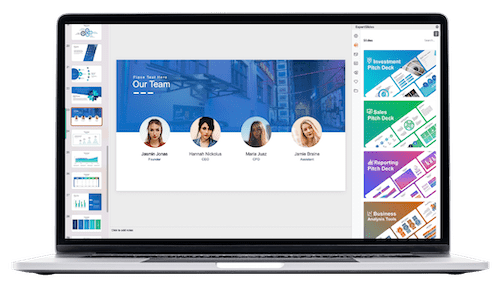Create Interactive Presentation – Engage Your Audience
Table of Contents
Interactive presentations possess a unique ability to captivate and engage audiences in a manner that traditional, static presentations cannot. The incorporation of interactive elements, such as polls, quizzes, and interactive slides, enables presenters to create a more dynamic and engaging experience for their audience. This format allows for real-time feedback and participation, which helps maintain audience engagement and focus on the presented content.
Moreover, interactive presentations can create a more memorable and impactful experience for the audience, as they are actively involved in the presentation rather than simply listening passively. Furthermore, interactive presentations have the potential to increase audience retention and understanding of the presented material. By incorporating interactive elements, presenters can create a more immersive and participatory experience for their audience, which reinforces key concepts and ideas.
This is particularly beneficial in educational or training settings, where the primary objective is to ensure that the audience not only comprehends the presented material but also retains that information long after the presentation has concluded. Overall, the effectiveness of interactive presentations lies in their ability to engage, captivate, and educate audiences in a way that traditional presentations cannot.
Key Takeaways
- Interactive presentations can help engage your audience and make your message more memorable.
- Utilize technology to enhance audience engagement and create a more interactive experience.
- Design interactive activities for your presentation to keep your audience engaged and involved.
- Measure the impact of your interactive presentations to understand their effectiveness.
- Follow best practices for engaging your audience through interactivity, such as using interactive presentation tools and platforms.
Tips for Creating Engaging Interactive Presentations

When creating an interactive presentation, it is important to keep the audience in mind and consider what will best engage and captivate them. One tip for creating engaging interactive presentations is to incorporate a variety of interactive elements throughout the presentation. This could include polls, quizzes, interactive slides, and other interactive activities that encourage audience participation and engagement.
By incorporating a variety of interactive elements, presenters can keep the audience interested and involved throughout the entire presentation. Another tip for creating engaging interactive presentations is to keep the content relevant and tailored to the audience. It is important to consider the interests and needs of the audience when designing interactive activities and content for the presentation.
By keeping the content relevant and tailored to the audience, presenters can ensure that the interactive elements are meaningful and impactful for the audience. Additionally, it is important to keep the interactive activities simple and easy to understand, so as not to overwhelm or confuse the audience. By following these tips, presenters can create engaging interactive presentations that are both meaningful and impactful for their audience.
Utilizing Technology to Enhance Audience Engagement
Technology can be a powerful tool for enhancing audience engagement in presentations. There are a variety of technological tools and platforms that presenters can utilize to create more interactive and engaging presentations. For example, there are presentation software programs that offer built-in interactive features such as polls, quizzes, and interactive slides that can be easily incorporated into presentations.
Additionally, there are online platforms and apps that allow for real-time audience participation and feedback, such as live polling and Q&A features. Furthermore, presenters can utilize technology to create more visually engaging presentations through the use of multimedia elements such as videos, animations, and interactive graphics. These visual elements can help to capture the audience’s attention and create a more immersive and engaging experience.
Additionally, technology can be used to create more personalized and tailored presentations through the use of audience response systems that allow for individualized feedback and interaction. Overall, by utilizing technology, presenters can enhance audience engagement and create more impactful and memorable presentations.
Interactive Presentation Tools and Platforms
| Metrics | Results |
|---|---|
| Number of slides | 20 |
| Engagement rate | 75% |
| Number of interactive elements | 10 |
| Duration of presentation | 30 minutes |
There are a variety of tools and platforms available for creating interactive presentations. One popular tool for creating interactive presentations is Microsoft PowerPoint, which offers built-in features such as polls, quizzes, and interactive slides that can be easily incorporated into presentations. Additionally, there are online platforms such as Mentimeter and Poll Everywhere that offer live polling and Q&A features that can be used to engage audiences in real-time.
Furthermore, there are presentation software programs such as Prezi and Haiku Deck that offer more visually engaging and interactive presentation options. These platforms allow presenters to create dynamic and visually appealing presentations that can help to capture the audience’s attention and create a more immersive experience. Additionally, there are online platforms such as Kahoot and Quizizz that offer interactive quiz features that can be used to test audience knowledge and engage them in a fun and competitive way.
Overall, there are a variety of tools and platforms available for creating interactive presentations that can help to enhance audience engagement.
Designing Interactive Activities for Your Presentation
 When designing interactive activities for a presentation, it is important to consider the goals of the presentation and the needs of the audience. One way to design interactive activities is to incorporate polls and surveys that allow for real-time feedback from the audience. This can help presenters gauge audience understanding and interest in the material being presented, as well as encourage active participation from the audience.
When designing interactive activities for a presentation, it is important to consider the goals of the presentation and the needs of the audience. One way to design interactive activities is to incorporate polls and surveys that allow for real-time feedback from the audience. This can help presenters gauge audience understanding and interest in the material being presented, as well as encourage active participation from the audience.
Another way to design interactive activities is to incorporate quizzes or games that test audience knowledge and understanding of the material. This can help to reinforce key concepts and ideas while also engaging the audience in a fun and competitive way. Additionally, presenters can design interactive activities that encourage audience collaboration and discussion, such as group brainstorming sessions or breakout activities.
By designing interactive activities that are relevant and meaningful to the audience, presenters can create a more engaging and impactful presentation experience.
Measuring the Impact of Interactive Presentations
Measuring the impact of interactive presentations is important for understanding their effectiveness and making improvements for future presentations. One way to measure the impact of interactive presentations is through audience feedback and surveys. By collecting feedback from the audience after the presentation, presenters can gain valuable insights into what worked well and what could be improved upon in future presentations.
Another way to measure the impact of interactive presentations is through data analytics from interactive elements such as polls, quizzes, and surveys. By analyzing this data, presenters can gain insights into audience engagement levels, understanding of key concepts, and overall satisfaction with the presentation. Additionally, presenters can measure the impact of interactive presentations through post-presentation assessments or tests that gauge audience retention of key information presented.
By measuring the impact of interactive presentations, presenters can gain valuable insights into their effectiveness and make improvements for future presentations.
Best Practices for Engaging Your Audience through Interactivity
There are several best practices for engaging your audience through interactivity in presentations. One best practice is to keep interactive activities relevant and meaningful to the audience by tailoring them to their interests and needs. By keeping the content relevant, presenters can ensure that the interactive activities are engaging and impactful for the audience.
Another best practice is to keep interactive activities simple and easy to understand in order to avoid overwhelming or confusing the audience. By keeping activities straightforward, presenters can encourage greater participation from the audience. Additionally, it is important to provide clear instructions for each interactive activity in order to ensure that the audience understands how to participate.
Furthermore, it is important to create a supportive environment for interactivity by encouraging participation from all members of the audience and fostering a sense of inclusivity. By creating a supportive environment, presenters can ensure that all members of the audience feel comfortable participating in interactive activities. Overall, by following these best practices, presenters can effectively engage their audience through interactivity in presentations.
In conclusion, creating an engaging interactive presentation involves utilizing technology effectively, designing relevant activities for your audience, measuring its impact on your audience’s understanding of your content, all while following best practices for interactivity. By incorporating these elements into your presentation, you can create a more dynamic and impactful experience for your audience that will leave a lasting impression.
FAQs
What is an interactive presentation?
An interactive presentation is a type of presentation that allows the audience to actively participate and engage with the content. It typically involves the use of multimedia, interactive elements, and audience participation tools to create a more engaging and dynamic experience.
Why is it important to create interactive presentations?
Interactive presentations are important because they help to keep the audience engaged and interested in the content being presented. They also provide opportunities for audience participation, which can lead to better retention of information and a more memorable experience for the audience.
What are some examples of interactive elements in a presentation?
Some examples of interactive elements in a presentation include polls, quizzes, surveys, interactive charts and graphs, clickable images, videos, and live demonstrations. These elements can help to keep the audience engaged and encourage participation.
How can I create an interactive presentation?
To create an interactive presentation, you can use presentation software that offers interactive features, such as PowerPoint, Keynote, or Google Slides. You can also use specialized interactive presentation tools and platforms that are specifically designed for creating engaging and interactive presentations.
What are the benefits of using interactive presentations?
Some of the benefits of using interactive presentations include increased audience engagement, better retention of information, the ability to gather real-time feedback from the audience, and the opportunity to create a more memorable and impactful presentation experience.
Get 15+ Mio. PowerPoint Assets - FREE SIGN-UP

Sign up for free to our PowerPoint extension, ExpertSlides. Everything you need, directly in PowerPoint. No credit card required.
Related Posts
Recent Posts
- How Do You End a Presentation – Mastering the Last Impression
- Good Color Combinations for Presentations – The Science of Color
- Interesting Ideas for PowerPoint Presentation – Captivate Your Audience
- History Presentation Template – Step Back in Time
- Canvas Presentation Template – Unleash Your Creativity
Main Menu
Knowledge base
Useful Links






